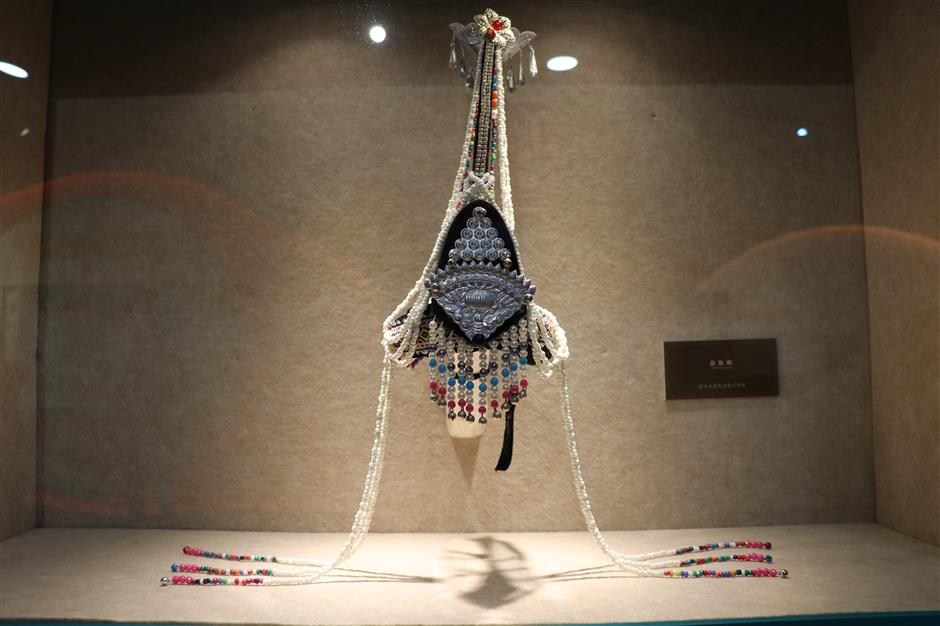Wuyi County artifacts highlight rural creativity
Building museums in rural areas is part of the Zhejiang government's 14th Five-Year Plan (2021-2025), which advocates for high-quality development to achieve shared prosperity.
The goal is to improve the people's cultural lives and protect village-based intangible heritage. Wuyi County in central Zhejiang Province is striving to become a model of common prosperity and has built museums in rural areas.
Now, 88 crafts and antiquities from Wuyi's rural museums are on display at the Zhejiang Museum of Natural History until July 12.
A portion of Wuyi County is surrounded by dense bamboo forests. Locals are exceptionally adept at weaving bamboo strips. They begin learning how to knit and braid at a young age. The majority of their sophisticated bamboo trinkets, necessities and utensils are handmade.
In addition to bamboo strip-made daily necessities, the Wuyi people also valued lacquered goods.

Lacquered dowry items showcase the aristocratic way of life in Wuyi County from centuries ago.
In ancient times, Wuyi residents would prepare red utensils for the wedding days to create an auspicious atmosphere and pray for prosperity. Each item was painted with red lacquer. The larger and more valuable the dowry, the higher their daughter's status in her new family.
The majority of dowries consisted of wooden furnishings, including beds, wardrobes, shelves and tables. The couple would use the intricately carved objects throughout their lives.
Mandarin ducks and peonies are seen as signs of good fortune. The mandarin ducks, often appearing in pairs, symbolize a happy marriage. It is believed that they are the loveliest designs for a bride's dowry and wedding ceremony.
Poeny, also known as the "king of flowers," represents honor, prosperity and aristocracy, in addition to love, affection and feminine beauty.
The Qing Dynasty (1644-1911) lacquered food container on display was used to carry food. The lacquered object was resistant to moisture, heat and corrosion, as well as being smooth and glossy. It was coated with approximately 100 layers of dried, smoothed, and polished lacquer, making it substantial enough to be carved with intricate designs.
Due to the time-consuming procedure and high cost, lacquered food containers were a luxury item reserved for the wealthy. The exhibits showcase the aristocratic way of life from centuries ago.

An ornate hat worn by the She people in Liucheng Town
Liucheng Town in Wuyi County is home to members of the She (畲) ethnic minority who migrated from Fujian Province to the mountainous region of central Zhejiang Province hundreds of years ago. They have managed to preserve their unique culture and traditions.
The ongoing exhibit features She-style costumes. During festivals and ritual ceremonies, women don garments with intricate embroidery. The majority of their intricate, colorful costumes are handmade. In contrast to traditional Chinese embroidery, the She people create simplistic and vibrant patterns.
Women during the late Qing Dynasty utilized traditional She-style purses. The pouch was typically a small, soft bag containing fragrant herbs or sweet-smelling objects. This ornament was worn to absorb sweat, repel insects and protect against evil.
The ability to sew intricate purses became a requirement for women at the time. Different stitching techniques were used to create an exquisite small purse. Floral designs and auspicious animal motifs were prevalent. They were believed to represent the ancient individual's zeal for life.
Yunjian (云肩) was also a popular item that often featured embroidery. They were not only used to prevent garments from becoming stained but were also worn as jewelry by women.
The exhibition features a few Yunjian displays from the late Qing Dynasty that were designed with symmetrical forms and a striking color contrast.

Embroidered Yunjian
Exhibition info
Date: Through July 12 (closed on Mondays), 9am-5pm
Admission: Free
Venue: Zhejiang Museum of Natural History
Address: No. 6, West Lake Cultural Square
西湖文化广场6号
















